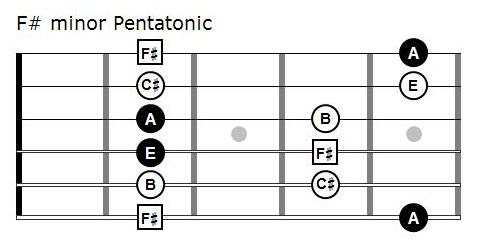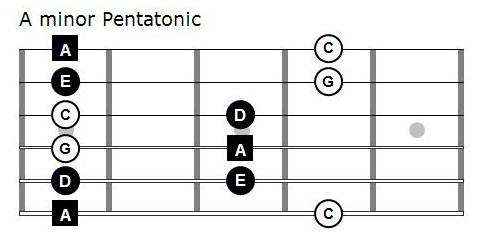Fundamentals of Improvisation
Before you start trying to make up your own guitar solos, you need to have some basic skills mastered with a capital “M.” Ideally, you should be able to play all of the pentatonic scales in all 12 keys at 140 bpm in 8th notes, and should be able to do the advanced exercises I have in my book at 120 bpm in quarter notes. You also need to know what scales to play if some says “We’re doing a Blues in A,” or “We’re doing a Blues in E.” Once you can do that, you’re ready to try playing along to backing tracks with the scales you know. You should have enough knowledge of music theory that you know you can use either an A minor pentatonic scale or a C major pentatonic scale to play over the chords C, F, and G. If you’ve got these concepts under your belt, then try working on these three ideas.
Know where the notes are in the scale
Specifically, try to learn where the root notes of the chords you’re playing over are in the minor pentatonic scale. Blues progressions are based on I – IV – V chord progressions; as an example, a blues in the key of A major would consist of the chords Amaj, Dmaj, and Emaj, or these sort of “chords:”

I put the word “chord” in quotes because what you see in the music above are not full chords since there are only two notes. They’re actually perfect 5th and major 6th intervals, and are usually referred to as A5 and A6 or D5 and D6 for short in sheet music. In a blues progression, they function the same as an actual chord.
If you were to improvise over a blues progression with these kinds of chords you should try to begin or end your phrases on the root notes of these chords in the minor pentatonic scale. They can be found here (black circles):

Notice though that there is no “D” note in the scale. You can try using the F# note instead, as the Dmaj chord consists of the notes D, F#, and A. This brings me to the next tip . . .
Try not using the relative minor
Instead use the minor scale over the major key. That is, for a blues in A major, use an A minor pentatonic scale (that is, starting at the 5th fret), which is technically the key of C. It will give you a different sound, more of a gritty, down and dirty kind of blues. Check out the notes in the diagram below:

Notice that with this scale, you’ve got the root notes of all three chords that you’re playing over. This approach works with any key – E minor pentatonic over a blues progression in E major, D minor over a blues in D major.
Try playing one octave patterns over the chord changes
Using the “minor scale over the major key” approach, try playing one octave patterns over each measure. For a blues in A, using the scale above, you’d play A – C – D – E – G – A over the A chord. Then play D – E – G – A – C – D over the D chord, and E – G – A – C – D – E over the E chord. You’re just doing this to get comfortable with the location of the root notes; after a week of doing this, try using those one octave sections to make up your own phrases and riffs.
Close your eyes and wing it
Of course, you don’t want to be totally left-brained in your approach to this. You should also spend some time not thinking about what chord you’re playing over and just listen to the music you’re trying to improvise over and be inspired by it. If you practice improvisation for 30 minutes a day, spend half your time working on the first three things I talked about in this post, then spend the rest of the time winging it and letting divine inspiration take over.